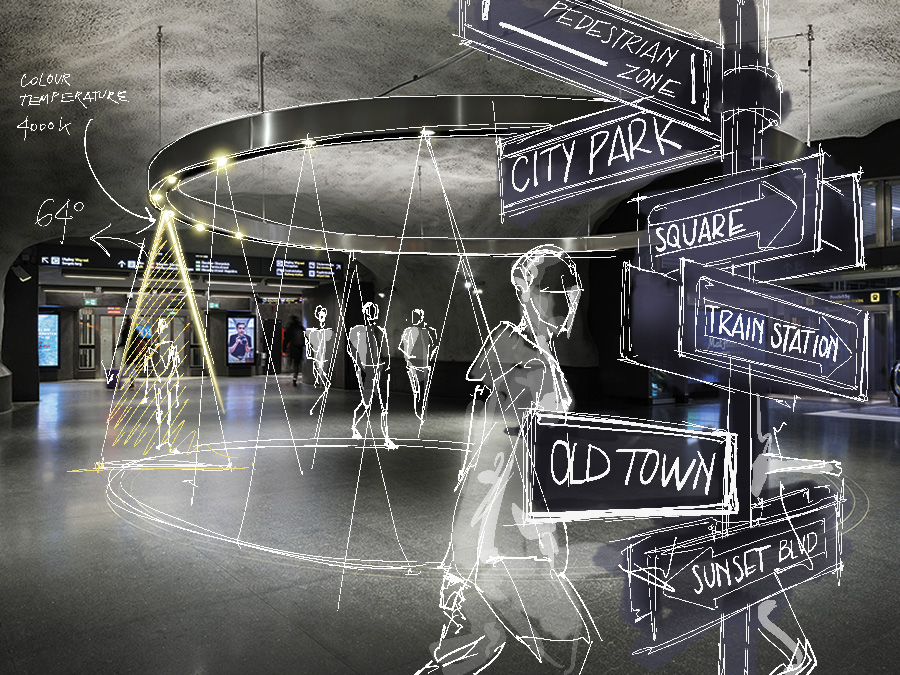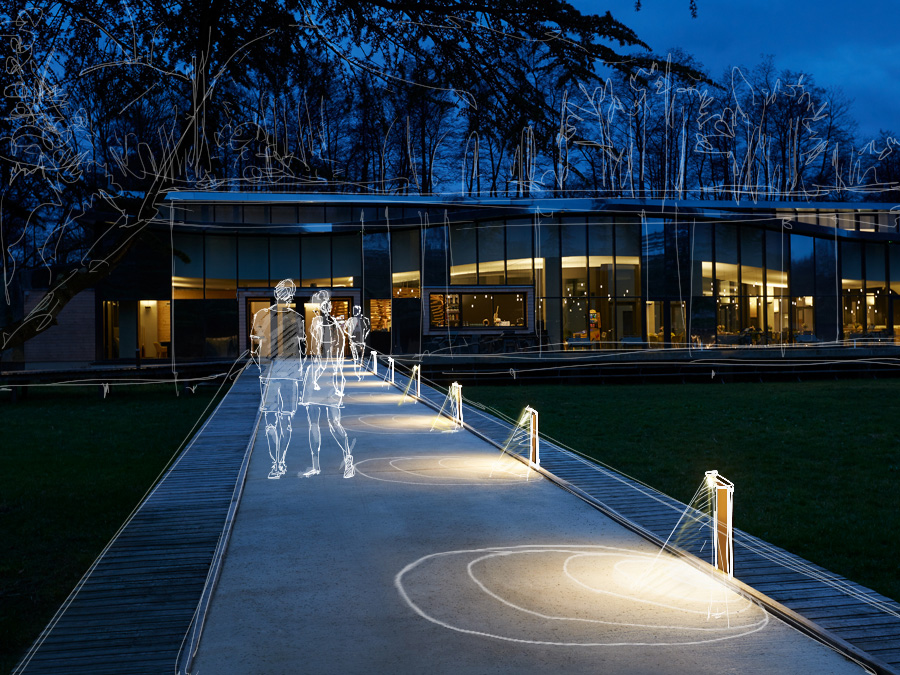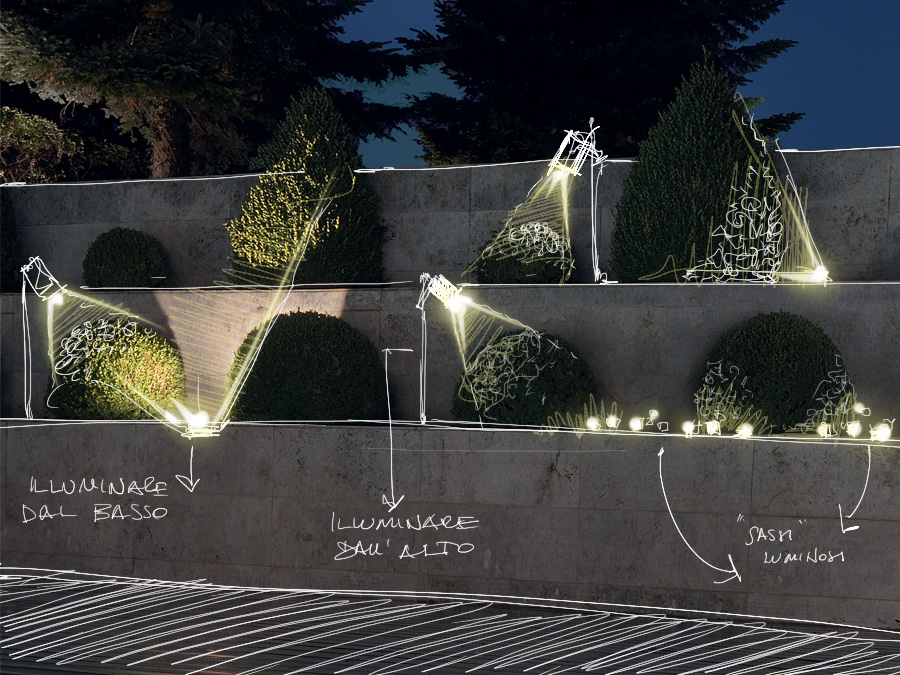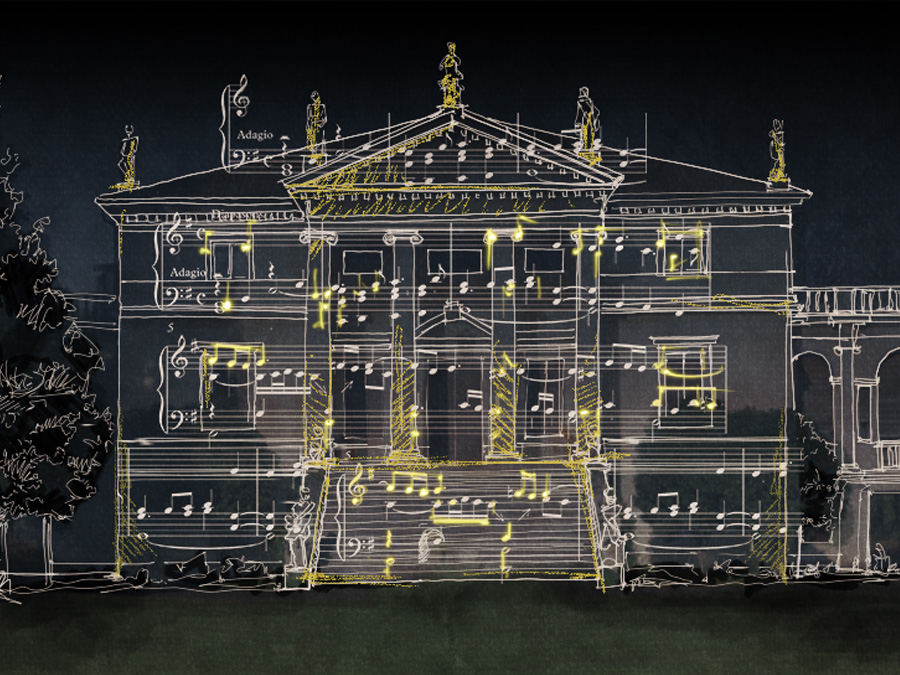In the previous instalment, we followed a flâneur as he wandered around a modern-day metropolis observing the relationship between light and urban design. We continue our walk with him now.
An outdoor living room
Between pedestrian zones and low traffic neighbourhoods, a square opens in all its grandeur.
Our observer’s thoughts focus on the “furnishings” in this place, which aim to create a sense of community, a space that says to people: “Make yourself comfortable, meet up with friends, take time to chat.” Squares are the places where we are all one family.
The people’s living room is furnished with benches, flowerbeds and architectural elements that all require lighting. Below, flowerbeds and trees are lit from the ground with uplights, and benches are flanked by columns with linear profiles emitting diffuse light.

Rondò 1.1, 3000K, 2W, radial, micro blasted Find out more about the product
Smoothy 2.4, 3000K, 7W, 34° Find out more about the product

Rio 2, 2800K, 19W/m Go to the project and credits
Italy has some of the oldest squares in the world; to light large spaces and historical monuments without damaging them, one solution is to use projectors mounted on poles, as in the photos below.

Siri 2.0, 3000K, 16W, 6°, anthracite Find out more about the product
Stra 1.0, 3000K, 37W, wall washer Find out more about the product

Flori 1.0, 3000K, 7W, 9°, anthracite, with fastener strap Find out more about the product
In these cases, the right installation accessories are essential to providing light without invading the architectural project.
🔶 Fastener straps,
🔶 arms to fix the devices to the wall,
🔶 plates for mounting them in a corner.
And, of course, in addition to being strong and sturdy, the fixtures need, as far as possible, to be sleek, minimal and in tone with their setting, so that they can effectively “disappear” into it.
If, on the other hand, the lighting project is part of the creation of a new meeting space, we can view the light factor innovatively, as an added value with no technical constraints: at that point the light can aim to be experiential and to define a place in terms of its identity and the use it is put to.
These “light pixels”, seen from the drone’s eye view, are actually squares made with diffuse-light profiles mounted on casings custom-made for the project. They have taken on an unexpected “interactive” function, having become the preferred settings for photos and selfies, as if podiums made of light. In the background, the magnificent view of the Çamlıca Mosque in Istanbul.

Rio 2, 19W/m, version with customized installation and 2200K colour temperature Go to the project and credits
This is the experience that inspired our reflections on cities’ Instagrammability and on how to use lighting to achieve it in a place that is a little off the beaten track.
💡 📞 💡
All our lighting fixtures’ features – aesthetic, electronic, optical and LED – can be customized.
Not enough? Perhaps you have an entirely new fixture in mind? Try us!
Face-to-facade meetings
The architecture of the buildings, private residences and offices comes to life:
in the depths of the night, light gives definition to the structures’ substance, caressing the surface of the built world.
No self-respecting city stroll can fail to take in the buildings and edifices that line the streets, making up the architecture in an urban centre.
The projects below are not intended to exhaust the subject but rather to inspire a reflection on the role of light for facades.
There are many objectives that can be achieved with facade lighting: brand communication and distinctiveness (photo on the left) and increased aesthetic appeal of an otherwise grey and anonymous neighbourhood (photo on the right) are just two.
📰 Read our article on lighting facades here

Neva 2.2, 3000K, 27W, 11°, with brackets / Neva 5.2, RGB, 50W, 24°x46°, with brackets
Go to the project and credits

Goccia 2.6, 4000K, 2W Go to the project and credits
Superheroes combating agents of grime
After letting our thoughts soar briefly to urban building facades, let’s return to our flâneur with his feet on the ground and observe the luminaires embedded in it.
🔶 In the choice of recessed outdoor solutions in urban contexts, the degree of protection offered against dust and moisture is a decisive factor. Our heroes must guarantee a protection rating of at least IP54 (protection against solids smaller than a millimetre and splashing water).
🔶 Let us assume for a moment that our flâneur has X-ray vision and can see beyond the visible to probe the fittings’ outer casings. We’ll take the case of a space realised in concrete where we need to install a fixture with a protection rating of IP68, but where it’s not possible to drain water from the outer casing as usual. We'll use a casing that has been designed to maintain the IP68 protection rating of the product installed in it. The outer casing in question has a gasket and cable glands that prevent water from entering and keep the appliance dry. It is therefore completely watertight and does not require drainage capabilities.
🔶 What if we choose a lighting fixture with adjustable optics?
Opening fixtures on rainy days or in areas of high humidity can cause condensation to form inside them. However, a great advantage of our fixtures is that you can adjust the optics without opening the fixture, so you don’t run the risk of compromising the protection by exposing it to atmospheric moisture.
There are various technologies available for directing the light output without opening the fixture:
- A magnet,
- A remote control for motorised optics,
- Adjustment using a screw or a pin at the base of the fixture .

Adjustment using a magnet Find out more about the product 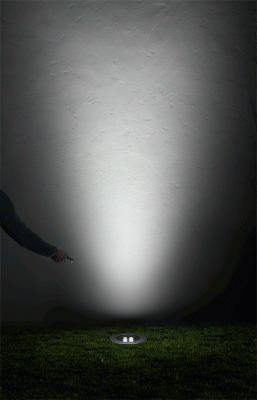
Motorized adjustable optics Find out more about the product 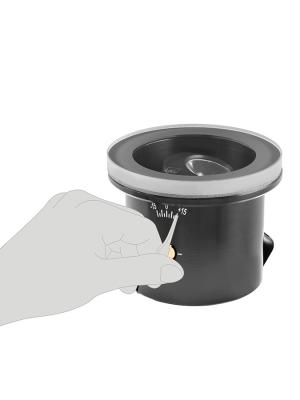
Adjustment using a screw Find out more about the product 
Adjustment using a pin Find out more about the product
🔶 In the evening hours or before dawn, our wandering alter ego encounters some municipal workers using high pressure, high temperature jets and pressure washers to clean public areas. Protection rating IP69K guarantees the fixture’s continued correct operation and resistance even when it is cleaned daily in this way.
Easy Rider
With our finger on the city map, we continue to follow our hero. In his wanderings, he has now arrived near a large car park. We see him starting to think about car traffic and how it impacts on urban spaces and their lighting.
To be able to bear the load of a car, the lighting fixture must be drive-over – this is indicated in the technical documentation by the value in kg or kN of the maximum weight borne. To be considered drive-over, a lighting fixture must undergo three tests: static load, torsion test and sliding test.
In the first photo, the linear profiles recessed into the ground physically demarcate the parking space. In the second photo, the parking space is created with light from the radial optics of the lighting fixtures.
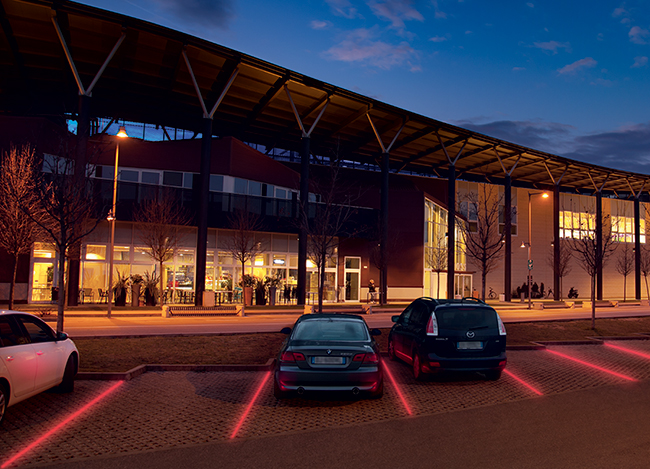
Rio 1.0, RGB, 4.5W Find out more about the product

Rondò 1.2, 3000K, 4W, radial optics, anthracite Find out more about the product
One factor that should never be underestimated in cities is vandalism. To avoid any possibility of tampering that would compromise the fixtures’ operation, the products can be fitted with special anti-vandal screws. However, there is no need for a tamper-resistant screw to compromise the product’s aesthetics if it is painted in the same colour as the fixture body so that it blends in.

Rondò 1.2, cor-ten Find out more about the product

Rondò 3.1, 2700K, 3W, radial, anthracite Find out more about the product
Around and around we go
Leaving the car park, our flâneur follows a car with his eyes as it quickly merges with the city traffic and stops at the entrance to aroundabout. A roundabout is a chameleon-like urban space. Depending on the choices made by the town planners, it can be totally minimal and anonymous, or it can become an artistic work symbolising the town.
Lighting has a functional purpose, of course, guaranteeing visibility and safe driving. However, looking at the projects carried out in recent years, it is clear that the work of the architectural lighting – and thus the choice of lighting fixture and its technical characteristics – on a roundabout will depend entirely on its uniqueness and on the architectural element that is to be enhanced.
The statue in the photo on the left is lit from bottom to top by projectors in the white base, while, in the fountain on the right, it is the underwater projectors with RGB colour LEDs that set the personality and distinctiveness of the entire piece.
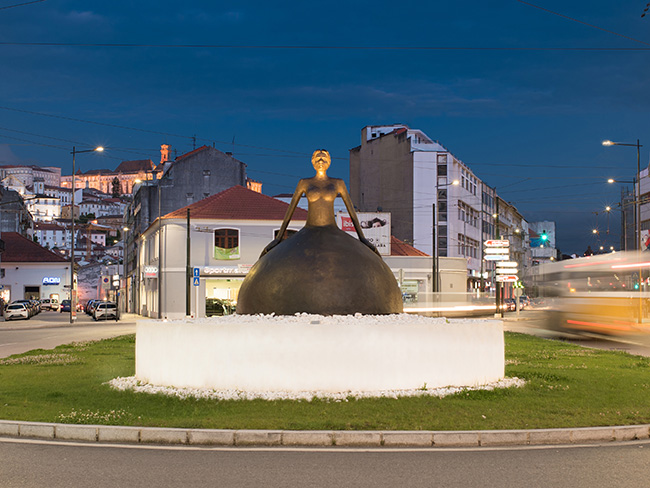
Siri 2.0, 3000K, 16W, 30°, grey Go to the project and credits
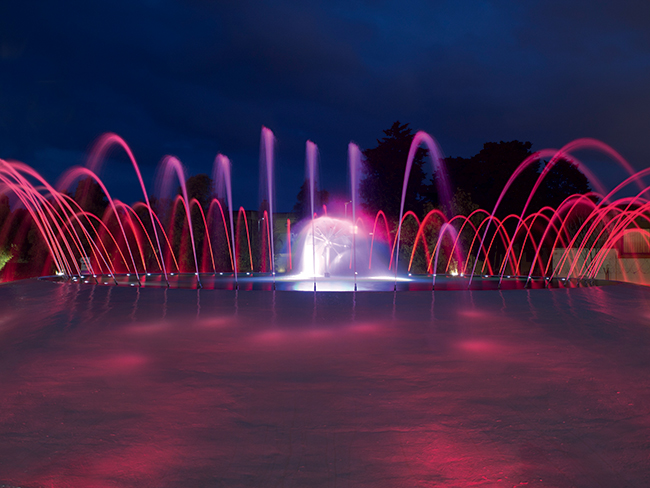
Spot 3.0 316L, RGB, 18W Go to the project and credits
Next stop
Tired of walking, the flâneur arrives at a station to continue his wanderings by public transport. Imagine arriving there after dusk, perhaps on a winter’s evening, when everything is shrouded in a ghostly fog. Has this ever happened to you?
Station lights should help us orientate ourselves, make it easier to access and use the space and, no less importantly, make us feel safe as we wait impatiently for the last train home. Upgrading stations with LED solutions achieves these objectives while also reducing energy and maintenance costs.

Rio 2, 3700K, 19W/m Go to the project and credits

Rio 2, 2800K, 19W/m Go to the project and credits
Stations also consist of underground areas, with underpasses and corridors, and platforms for the metro trains, and light can be the element that gives breath and breadth to these narrow and sometimes claustrophobic places.

projector for outdoor applications, 4000K, 20W, 64°, anthracite Go to the project and credits
If asymmetrical optics are chosen, a wall light can illuminate the area in front of a bench, or a transit area can be lit with just a few fixtures installed high up, the asymmetrical output ensures that the light is directed efficiently at the floor.

Intono 4.1, 3000K, 19W, asymmetrical, anthracite Find out more about the product

Intono 4.1, 3000K, 19W, asymmetrical
The keen eye of our flâneur recognises that urban lighting can offer the opportunity to introduce unique and distinctive artistic installations. These enrich their surroundings culturally, turning zones viewed as being solely for transit into pleasant and lively areas.
Below the installation “Me.Here.Now” by Mark Titchner in the pedestrian zone of London Bridge Station.

projector for outdoor applications, 3000K, 20W, customized version with 19° optics, cor-ten Go to the project and credits
Sunset Park
Having returned to the surface, the flâneur makes his way towards the city park – let’s follow him as he walks through the “green lungs” of the city. Green space is now an essential element of urban liveability, and local authorities can jump to the top of the list of best cities based on the attention they pay to this aspect. What’s important to us here is giving public green spaces a night life through the use of lighting.
Judicious lighting allows spaces to be used even after sundown. People’s perception of safety is increased, and they feel encouraged to view these places as their own, rather than avoiding them due to the mistaken correlation of “park at night = crime”. Lighting should therefore be provided for footpaths and cycle paths through the park, and for rest areas such as benches.
At the same time, lighting must always be planned with one eye on protecting the starry sky from light pollution.
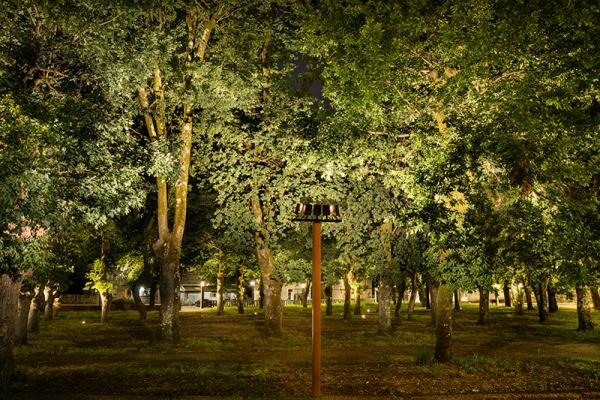
Siri 2.0, 16W, 4000K, 30° - 40°, cor-ten Go to the project and credits 
Stra 1.0, 37W, 3000K, 37°, with honeycomb louvre Go to the project and credits
In addition to improving safety and usability, light can also act as a “beauty filter” on plants and flowers, enhancing foliage, trunks and bright colours, and giving them three-dimensionality.
The subject of lighting greenery caught our attention a little while ago, so if you want to dive into the jungle yourself, look the articles Garden greenery 1, Garden greenery 2, and Garden greenery 3.
Dawn is breaking, the lights are going out. The flâneur has finished his contemplative nocturnal tour of the city and, having followed him on his walk, we shall try to summarise as follows.
In the first instalment of “Illuminated cities”, we noted how light can enable people to use spaces into the night and in complete safety, and how it lays the foundations for collective living. We also saw how a good dose of creativity mixed with lighting technology can mean social media snaps that go viral – with increasingly positive effects for the city, its community and tourism (as we impatiently await its return).
In this instalment, we’ve focused on specific public areas, such as squares or stations: different considerations arise in each case regarding the use of light and the choice of fixtures.
Have you used L&L lighting fixtures to light a corner of your city?

